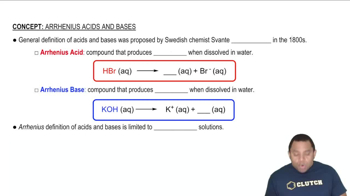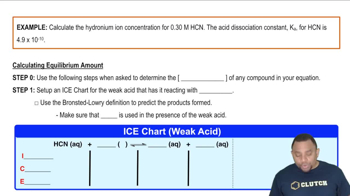Ch.21 - Transition Elements and Coordination Chemistry
Chapter 21, Problem 141
Consider the following reaction, and assume that its equilibrium constant is 1.00 * 10^14: (a) Write the equilibrium equation for the reaction, and explain why CrO4^2- ions predominate in basic solutions and Cr2O7^2- ions predominate in acidic solutions. (b) Calculate the CrO4^2- and Cr2O7^2- concentrations in a solution that has a total chromium concentration of 0.100 M and a pH of 4.000. (c) What are the CrO4^2- and Cr2O7^2- concentrations if the pH is 2.000?
 Verified step by step guidance
Verified step by step guidance1
Step 1: Write the equilibrium equation for the reaction. For the equilibrium between chromate (CrO4^2-) and dichromate (Cr2O7^2-) ions, the equation is: 2 CrO4^{2-} + 2 H^+ \rightleftharpoons Cr2O7^{2-} + H2O. This equation shows the interconversion between chromate and dichromate ions in the presence of hydrogen ions.
Step 2: Explain the predominance of ions in different pH conditions. In basic solutions, the concentration of H^+ ions is low, which shifts the equilibrium to the left, favoring the formation of CrO4^2- ions. In acidic solutions, the concentration of H^+ ions is high, shifting the equilibrium to the right, favoring the formation of Cr2O7^2- ions.
Step 3: Calculate the concentrations of CrO4^2- and Cr2O7^2- at pH 4.000. Use the equilibrium constant expression K = [Cr2O7^{2-}][H2O]/([CrO4^{2-}]^2[H^+]^2) = 1.00 \times 10^{14}. Assume [H2O] is constant and incorporate the total chromium concentration to set up the system of equations.
Step 4: Solve the system of equations for pH 4.000. Use the relationship [H^+] = 10^{-pH} to find [H^+] at pH 4.000. Substitute this value into the equilibrium expression and the total chromium concentration equation: [CrO4^{2-}] + [Cr2O7^{2-}] = 0.100 M.
Step 5: Repeat the calculation for pH 2.000. Use the same approach as in Step 4, but with [H^+] = 10^{-2} for pH 2.000. Substitute this into the equilibrium expression and solve the system of equations to find the concentrations of CrO4^2- and Cr2O7^2-.
Key Concepts
Here are the essential concepts you must grasp in order to answer the question correctly.
Equilibrium Constant
The equilibrium constant (K) quantifies the ratio of concentrations of products to reactants at equilibrium for a given reaction at a specific temperature. A large K value, such as 1.00 * 10^14, indicates that the products are favored at equilibrium, meaning the reaction strongly favors the formation of products over reactants. Understanding K helps predict the direction of the reaction and the relative concentrations of species involved.
Recommended video:
Guided course

Equilibrium Constant K
Acid-Base Chemistry
Acid-base chemistry involves the transfer of protons (H+) between species, influencing the forms of certain ions in solution. In acidic solutions (low pH), there is a higher concentration of H+ ions, which can lead to the predominance of Cr2O7^2- ions due to the reaction of CrO4^2- with H+. Conversely, in basic solutions (high pH), the lower concentration of H+ favors the formation of CrO4^2- ions, demonstrating how pH affects the equilibrium between these species.
Recommended video:
Guided course

Arrhenius Acids and Bases
pH and Ion Concentration
pH is a measure of the hydrogen ion concentration in a solution, influencing the speciation of ions. The relationship between pH and the concentrations of CrO4^2- and Cr2O7^2- can be calculated using the equilibrium constant and the total chromium concentration. By applying the Henderson-Hasselbalch equation or equilibrium expressions, one can determine how changes in pH affect the distribution of these chromium species in solution.
Recommended video:
Guided course

Hydronium Ion Concentration Example
Related Practice
